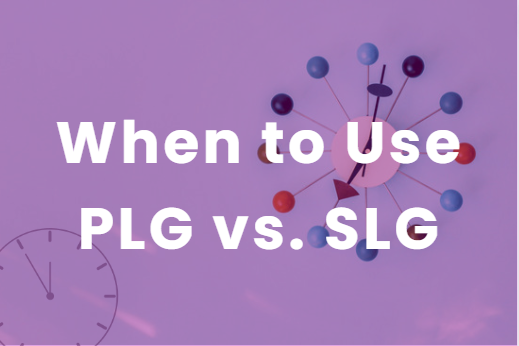PLG vs. Sales-Led Growth: Which Strategy Is Right for Your Business?
-
Bella Williams
- 10 min read

 In the ever-evolving landscape of business growth strategies, it’s essential to choose the right approach that aligns with your goals and target audience. Two prominent strategies, Product-Led Growth (PLG) and Sales-Led Growth, offer distinct paths to success. In this article, we’ll delve deep into these strategies, highlighting their differences, providing practical examples, and offering guidance on when to deploy each.
In the ever-evolving landscape of business growth strategies, it’s essential to choose the right approach that aligns with your goals and target audience. Two prominent strategies, Product-Led Growth (PLG) and Sales-Led Growth, offer distinct paths to success. In this article, we’ll delve deep into these strategies, highlighting their differences, providing practical examples, and offering guidance on when to deploy each.
What is PLG?
Product-led growth, often referred to as PLG, is an innovative approach that places the product itself at the forefront of customer acquisition and retention. In essence, the product becomes the primary salesperson. Users are empowered to sign up, onboard, and explore the product’s value independently, with minimal to no direct sales involvement.
Key Features of PLG
- Product Excellence: The heart of PLG is a product that stands out as exceptional. It must be so compelling that users not only want to use it but also share it with others. Slack’s success story exemplifies this principle. Slack offers a user-friendly, feature-rich platform for team communication. Its intuitive design and efficiency make it a prime example of a product that sells itself.
- User Self-Service: In a PLG model, the onboarding process is designed to be self-service. Users should be able to create accounts, understand the product’s features, and start gaining value without needing extensive guidance. Dropbox, a widely used cloud storage service, allows users to sign up, install the application, and begin uploading and sharing files effortlessly. This self-service approach drives user adoption.
- Frictionless Onboarding: The goal of onboarding is to minimize any barriers or friction that might hinder user adoption. Consider the onboarding process of Zoom, the video conferencing platform. Users can join meetings without needing to create accounts, reducing friction and making it easy for anyone to use the product.
- Continuous Iteration: A hallmark of PLG is its focus on feedback and iteration. Companies actively seek user feedback and use it to improve the product continually. Airbnb, for example, regularly updates its platform based on user reviews and suggestions, enhancing the overall user experience.
What is Sales-Led Growth?
Sales-led growth is a traditional approach that relies on dedicated sales teams to identify leads, pitch products, negotiate deals, and ultimately close sales. This model places human interaction at the core of customer acquisition and retention.
In a Sales-Led Growth model, companies typically have specialized sales teams that reach out to potential customers through various channels, such as cold calls, emails, and in-person meetings. These sales teams nurture leads, answer questions, and guide customers through the sales process.
Major Difference Between Product-Led Growth and Sales-Led Growth
- User-centric Vs. Sale-centric:
The most prominent distinction between PLG and Sales-Led Growth is their primary focus. PLG is user-centric, prioritizing the user experience and empowering users to explore the product themselves.
Consider the case of insight7, which offers a free trial to users, allowing them to experience the service before making a purchase. This user-centric approach minimizes the need for direct sales involvement.
In contrast, Sales-Led Growth is sales-centric. It relies on human interaction to nurture leads and close deals. A prime example of a Sales-Led Growth company is Oracle, a multinational computer technology corporation. Oracle’s complex, enterprise-level solutions require in-depth discussions, customizations, and negotiations, making direct sales efforts essential.
- Speed and Efficiency
PLG often leads to faster adoption rates. Users can sign up, onboard themselves, and start experiencing the product’s value within minutes. A notable example of a fast-adoption PLG product is Grammarly, a writing assistance tool. Users can install the browser extension and begin using it to improve their writing instantly.
In contrast, Sales-Led Growth can be a slower process due to the involvement of sales teams. Consider the example of Salesforce, a company specializing in customer relationship management (CRM) solutions. Salesforce relies on dedicated sales teams that engage with businesses, analyze their needs, and propose tailored CRM solutions. This personalized approach may lead to longer sales cycles.
- Cost and Scalability
PLG can be more cost-effective in the long run. It doesn’t require extensive sales teams and their associated costs. This scalability is exemplified by companies like Canva, a graphic design platform. Canva offers a free, user-friendly design tool with a vast library of templates and features. Users can get started without needing direct sales support. Canva’s model allows for a large user base to grow without substantial increases in labor costs.
On the other hand, Sales-Led Growth can become expensive due to the need for a dedicated sales force. A notable example is IBM, a multinational technology company. IBM’s enterprise-level solutions often require complex negotiations and customization, which necessitate significant sales resources and, subsequently, higher costs.
When to Use Each Strategy
 When to Choose PLG:
When to Choose PLG:
PLG is an excellent choice when you have a product that can stand on its own. If your product is straightforward, user-friendly, and intuitive, and your target audience prefers self-service experiences, PLG is the way to go. Slack, as previously mentioned, is a prime example. Its chat platform is so intuitive and valuable that teams can start using it immediately.
PLG is often favored by SaaS companies, innovative tech startups, and products with clear use cases. For example, Zoom’s video conferencing platform is known for its simplicity and efficiency, making it an ideal candidate for PLG. Users can join meetings with minimal friction, which aligns with the self-service philosophy of PLG.
When to Choose Sales-Led Growth:
Sales-led growth is the preferred choice when your product is complex and requires in-depth explanation, negotiation, and customization. This approach is suitable for high-value B2B products, enterprise solutions, and industries where personal relationships are essential.
A prime example of Sales-Led Growth is Oracle, which offers intricate software solutions for businesses. Oracle’s products often involve extensive customization and consultation. Sales teams work closely with clients to understand their unique needs and tailor solutions accordingly.
In the world of business growth strategies, PLG and Sales-Led Growth represent two contrasting yet effective approaches. PLG places the product at the forefront, offering a user-centric, self-service experience, while Sales-Led Growth relies on human interaction and direct sales efforts. Choosing between these strategies depends on the nature of your product, your target audience, and your business goals.
FAQs
Can a company use both PLG and Sales-Led Growth simultaneously?
Yes, some companies adopt a hybrid model, combining elements of both strategies to cater to various customer segments. HubSpot, a leading marketing and CRM platform, combines PLG for its inbound marketing and sales efforts while offering a Sales-Led Growth model for its enterprise-level solutions.
Are there industries where PLG is more effective than Sales-Led Growth?
Yes, PLG is particularly effective in SaaS, tech startups, and industries with products that have straightforward, intuitive use cases. A notable example is Trello, a project management tool. Trello’s user-friendly interface and simple task management make it an ideal candidate for PLG.
What are the potential drawbacks of Sales-Led Growth?
Sales-led growth can be expensive due to the need for a dedicated sales force. It can also result in longer sales cycles. A case in point is the pharmaceutical industry, where sales representatives engage with healthcare professionals to promote and sell complex medications and medical equipment.
How can a company transition from a Sales-Led model to a PLG model?
Transitioning from a Sales-Led to a PLG model involves several steps. Companies need to reevaluate their product, user experience, and marketing strategies. A good example is Adobe, a software company that transitioned from selling physical software to offering a subscription-based model with Adobe Creative Cloud. They redesigned their products for a self-service experience, enabling users to access software and updates instantly.
Is one strategy definitively better than the other?
No, there isn’t a one-size-fits-all answer. The choice between PLG and Sales-Led Growth depends on the specific circumstances, the nature of the product, the target audience, and the business’s goals. The best approach is to align your strategy with your unique context and objectives.







